Studies of High-Temperature Fatigue Behavior and Mechanism for Nickel-Based Superalloy Inconel 625
Abstract
:1. Introduction
2. Material and Experimental Procedures
2.1. Material
2.2. Experimental Procedure
3. Results and Discussion
3.1. Cyclic Stress Responses
3.2. Microstructural Analysis
3.3. Fatigue Fractographic Analysis
3.4. Life Prediction
4. Conclusions
Author Contributions
Funding
Data Availability Statement
Conflicts of Interest
References
- Shoemaker, L.E. Alloys 625 and 725: Trends in properties and applications. In Superalloys 718, 625, 706 and Derivatives 2005; Loria, E.A., Ed.; The Minerals, Metals & Materials Society: Warrendale, PA, USA, 2005; pp. 409–418. Available online: https://www.tms.org/Superalloys/10.7449/2005/Superalloys_2005_409_418.pdf (accessed on 5 March 2021).
- Mataveli Suave, L.; Cormier, J.; Villechaise, P.; Soula, A.; Hervier, Z.; Bertheau, D.; Laigo, J. Microstructural evolutions during thermal aging of Alloy 625: Impact of temperature and forming process. Metall. Mater. Trans. A 2014, 45, 2963–2982. [Google Scholar] [CrossRef]
- Singh, J.B.; Chakravartty, J.K.; Sundararaman, M. Work hardening behaviour of service aged Alloy 625. Mater. Sci. Eng. A 2013, 576, 239–242. [Google Scholar] [CrossRef]
- Cinoglu, I.S.; Charbal, A.; Vermaak, N. Towards exploiting inelastic design for Inconel 625 under short-term cyclic loading at 600 °C. Mech. Mater. 2020, 140, 103219. [Google Scholar] [CrossRef]
- Wang, Y.; Wang, B.; Chen, L. High-temperature low-cycle fatigue behavior of 625 nickel-base superalloy welding joint. Appl. Mech. Mater. 2014, 618, 120–124. [Google Scholar] [CrossRef]
- Bui-Quoc, T.; Gomuc, R.; Biron, A.; Nguyen, H.; Masounave, J. Elevated temperature fatigue-creep behavior of nickel-base superalloy IN 625. In Low Cycle Fatigue; Solomon, G.H.H., Kaisand, L., Leis, B., Eds.; ASTM International: West Conshohocken, PA, USA, 1988; pp. 470–484. [Google Scholar]
- Evans, N.D.; Maziasz, P.J.; Shingledecker, J.P.; Yamamoto, Y. Microstructure evolution of alloy 625 foil and sheet during creep at 750 °C. Mater. Sci. Eng. A 2008, 498, 412–420. [Google Scholar] [CrossRef]
- Mathew, M.; Palanichamy, P.; Latha, S.; Jayakumar, T.; Rao, K.B.S.; Mannan, S.; Raj, B. Microstructural changes in alloy 625 due to creep and characterization using NDE techniques. Indian Met. 2010, 63, 449–452. [Google Scholar] [CrossRef]
- Mataveli Suave, L.; Cormier, J.; Bertheau, D.; Villechaise, P.; Soula, A.; Hervier, Z.; Hamon, F. High temperature low cycle fatigue properties of alloy 625. Mater. Sci. Eng. A 2016, 650, 161–170. [Google Scholar] [CrossRef]
- Yin, J.; Zheng, Q.; Peng, Z.; Zhang, X. Review of supercritical CO2 power cycles integrated with CSP. Int. J. Energy Res. 2019, 44, 1337–1369. [Google Scholar] [CrossRef]
- Ho, C.K. Advances in central receivers for concentrating solar applications. Sol. Energy 2017, 152, 38–56. [Google Scholar] [CrossRef]
- Ortega, J.; Khivsara, S.; Christian, J.; Ho, C.; Dutta, P. Coupled modeling of a directly heated tubular solar receiver for supercritical carbon dioxide Brayton cycle: Structural and creep-fatigue evaluation. Appl. Therm. Eng. 2016, 109, 979–987. [Google Scholar] [CrossRef] [Green Version]
- McMurtrey, M.D.; Rupp, R.E.; Barua, B.; Messner, M. Creep-Fatigue Behavior and Damage Accumulation of A Candidate Structural Material for Concentrating Solar Power Solar Thermal Receiver (Final Technical Report); Idaho National Lab.(INL): Idaho Falls, ID, USA, 2021. [Google Scholar] [CrossRef]
- Sarvghad, M.; Delkasar Maher, S.; Collard, D.; Tassan, M.; Will, G.; Steinberg, T.A. Materials compatibility for the next generation of Concentrated Solar Power plants. Energy Storage Mater. 2018, 14, 179–198. [Google Scholar] [CrossRef]
- Laporte-Azcué, M.; González-Gómez, P.A.; Rodríguez-Sánchez, M.R.; Santana, D. Material selection for solar central receiver tubes. Sol. Energy Mater. Sol. Cells 2021, 231, 111317. [Google Scholar] [CrossRef]
- Purohit, A.; O’Donnell, J.E.; Thiele, U. Fatigue strength and evaluation of creep damage during fatigue cycling of inconel Alloy 625. In American Nuclear Society Winter Meeting; Transactions of the American Nuclear Society: San Francisco, CA, USA, 1983; pp. 1–4. Available online: https://www.osti.gov/biblio/5906535 (accessed on 5 March 2021).
- Moore, I.J.; Taylor, J.I.; Tracy, M.W.; Burke, M.G.; Palmiere, E.J. Grain coarsening behaviour of solution annealed Alloy 625 between 600–800 °C. Mater. Sci. Eng. A 2017, 682, 402–409. [Google Scholar] [CrossRef]
- Floreen, S.; Fuchs, G.E.; Yang, W. The Metallurgy of Alloy 625. In Superalloys 718, 625, 706 and Various Derivatives; Loria, E.A., Ed.; The Minerals, Metals & Materials Society: Pittsburgh, PA, USA, 1994; pp. 13–37. Available online: https://www.tms.org/superalloys/10.7449/1994/Superalloys_1994_13_37.pdf (accessed on 5 March 2021).
- Ozawa, Y.; Ishikawa, T.; Takeda, Y. Characterization of crack tip damage zone formation on alloy 625 during fatigue crack growth at 750 °C by transmission EBSD method. In ASME 2017 Power Conference Joint With ICOPE-17; ASME: Charlotte, NC, USA, 2017; pp. 1–7. [Google Scholar] [CrossRef]
- Mathew, M.D.; Parameswaran, P.; Bhanu, S.R.K. Microstructural changes in alloy 625 during high temperature creep. Mater. Charact. 2008, 59, 508–513. [Google Scholar] [CrossRef]
- Liu, D.; Zhang, X.; Qina, X.; Ding, Y. High-temperature mechanical properties of Inconel-625: Role of carbides and delta phase. Mater. Sci. Technol. 2017, 33, 1610–1617. [Google Scholar] [CrossRef]
- Chakravartty, J.K.; Singh, J.B.; Sundararaman, M. Microstructural and mechanical properties of service exposed Alloy 625 ammonia cracker tube removed after 100,000 h. Mater. Sci. Technol. 2013, 28, 702–710. [Google Scholar] [CrossRef]
- Kohler, M. Effect of the elevated-temperature-precipitation in alloy 625 on properties and microstructure. In Superalloys 718, 625 and Various Derivatives; Loria, E.A., Ed.; The Minerals, Metals & Materials Society: Pittsburgh, PA, USA, 1991; pp. 363–374. Available online: https://www.tms.org/Superalloys/10.7449/1991/Superalloys_1991_363_374.pdf (accessed on 5 March 2021).
- Shankar, V.; Rao, K.B.S.; Mannan, S.L. Microstructure and mechanical properties of Inconel 625 superalloy. J. Nucl. Mater. 2001, 288, 222–232. [Google Scholar] [CrossRef]
- Rodriguez, P.; Rao, K.B.S. Nucleation and growth of cracks and cavities under creep-fatigue interaction. Prog. Mater. Sci. 1993, 37, 403–480. [Google Scholar] [CrossRef]
- Barrett, P.R.; Ahmed, R.; Menon, M.; Hassan, T. Isothermal low-cycle fatigue and fatigue-creep of Haynes 230. Int. J. Solids Struct. 2016, 88–89, 146–164. [Google Scholar] [CrossRef]
- He, L.; Zheng, Q.; Sun, X.; Hou, G.; Guan, H.; Hu, Z. M23C6 precipitation behavior in a Ni-base superalloy M963. J. Mater. Sci. 2005, 40, 2959–2964. [Google Scholar] [CrossRef]
- Li, H.; Jing, H.; Xu, L.; Han, Y.; Zhao, L.; Yang, S.; Tang, Z. Effect of strain rate induced M23C6 distribution on cyclic deformation behavior: Cyclic hardening model. Int. J. Plast. 2020, 127, 102634. [Google Scholar] [CrossRef]
- Zhang, P.; Zhu, Q.; Hu, C.; Wang, C.; Chen, G.; Qin, H. Cyclic deformation behavior of a nickel-base superalloy under fatigue loading. Mater Des. 2015, 69, 12–21. [Google Scholar] [CrossRef]
- Rahmani, K.; Nategh, S. Low cycle fatigue mechanism of René 80 at high temperature-high strain. Mater. Sci. Eng. A 2008, 494, 385–390. [Google Scholar] [CrossRef]
- Gorman, D.M.; Higginson, R.L.; Du, H.; McColvin, G.; Fry, A.T.; Thomson, R.C. Microstructural analysis of IN617 and IN625 oxidised in the presence of steam for use in ultra-supercritical power plant. Oxid. Met. 2012, 79, 553–566. [Google Scholar] [CrossRef] [Green Version]
- Moulin, G.; Arevalo, P.; Salleo, A. Influence of external mechanical loadings (creep, fatigue) on oxygen diffusion during nickel oxidation. Oxid. Met. 1996, 45, 153–181. [Google Scholar] [CrossRef]
- He, X.; Zhang, Y.; Shi, H.; Gu, J.; Li, C.; Kadau, K.; Luesebrink, O. Influence of orientation and temperature on the fatigue crack growth of a nickel-based directionally solidified superalloy. Mater. Sci. Eng. A 2014, 618, 153–160. [Google Scholar] [CrossRef]
- Christ, H.J.; Wackerman, K.; Krupp, U. On the mechanism of dynamic embrittlement and its effect on fatigue crack propagation in IN718 at 650 °C. Procedia Struct. Integr. 2016, 2, 557–564. [Google Scholar] [CrossRef]
- Kitaguchi, H.; Li, H.; Evans, H.; Ding, R.; Jones, I.; Baxter, G.; Bowen, P. Oxidation ahead of a crack tip in an advanced Ni-based superalloy. Acta Mater. 2013, 61, 1968–1981. [Google Scholar] [CrossRef]
- Tong, J.; Dalby, S.; Byrne, J.; Henderson, M.; Hardy, M. Creep, fatigue and oxidation in crack growth in advanced nickel base superalloys. Int. J. Fatigue 2001, 23, 897–902. [Google Scholar] [CrossRef]
- Ding, B.; Ren, W.; Zhong, Y.; Yuan, X.; Peng, J.; Zheng, T.; Shen, Z.; Guo, Y.; Xuan, W.; Yu, J.; et al. Analysis of the fully-reversed creep-fatigue behavior with tensile-dwell periods of superalloy DZ445 at 900 °C. Eng. Fract. Mech. 2021, 250, 107781. [Google Scholar] [CrossRef]
- Ding, B.; Ren, W.; Peng, J.; Zheng, T.; Hou, L.; Yu, J.; Ren, Z.; Zhong, Y. Damage mechanism and life prediction based on tensile-stress- and compressive-stress-dominated low-cycle fatigue of a directionally solidified Ni-based superalloy DZ445. Mater. Sci. Eng. A 2019, 742, 478–492. [Google Scholar] [CrossRef]
- Barat, K.; Sivaprasad, S.; Kar, S.K.; Tarafder, S. Low-cycle fatigue of IN 718: Effect of waveform. Fatigue Fract. Eng. Mater. Struct. 2019, 42, 2823–2843. [Google Scholar] [CrossRef]
- Wang, Q.; Zhang, N.; Wang, X. A new 3D creep-fatigue-elasticity damage interaction diagram based on the total tensile strain energy density model. Metals 2020, 10, 274. [Google Scholar] [CrossRef] [Green Version]
- Zhu, S.; Yang, Y.; Huang, H.; Lv, Z.; Wang, H. A unified criterion for fatigue-creep life prediction of high temperature components. Proc. Inst. Mech. Eng. Part G J. Aerosp. Eng. 2016, 231, 677–688. [Google Scholar] [CrossRef]
- Benedetti, M.; Berto, F.; Le, B.L.; Santus, C. A novel strain-energy-density based fatigue criterion accounting for mean stress and plasticity effects on the medium-to-high-cycle uniaxial fatigue strength of plain and notched components. Int. J. Fatigue 2020, 133, 105397. [Google Scholar] [CrossRef]
- Mukherjee, S.; Barat, K.; Sivaprasad, S.; Tarafder, S.; Kar, S.K. Elevated temperature low cycle fatigue behaviour of Haynes 282 and its correlation with microstructure-effect of ageing conditions. Mater. Sci. Eng. A 2019, 762, 138073. [Google Scholar] [CrossRef]
- Special Metals Corporation. Available online: https://www.specialmetals.com/documents/ technical-bulletins/inconel/inconel-alloy-625.pdf (accessed on 5 March 2021).
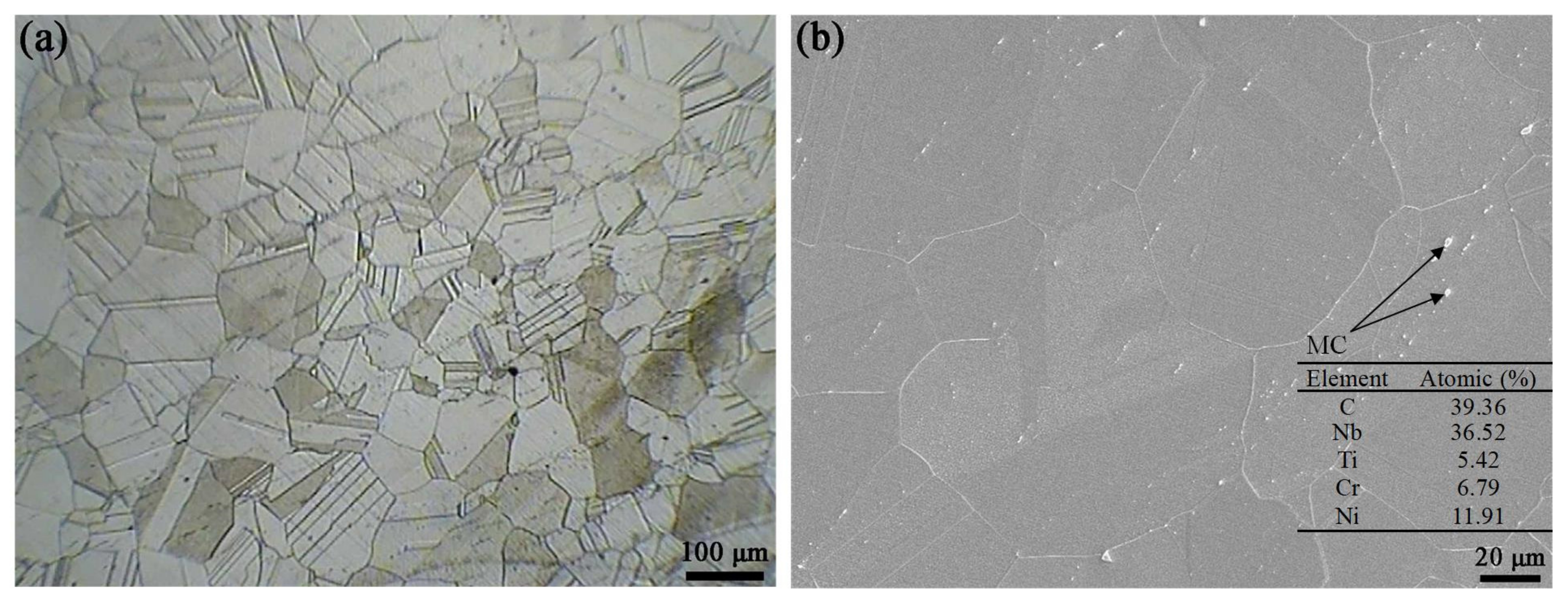
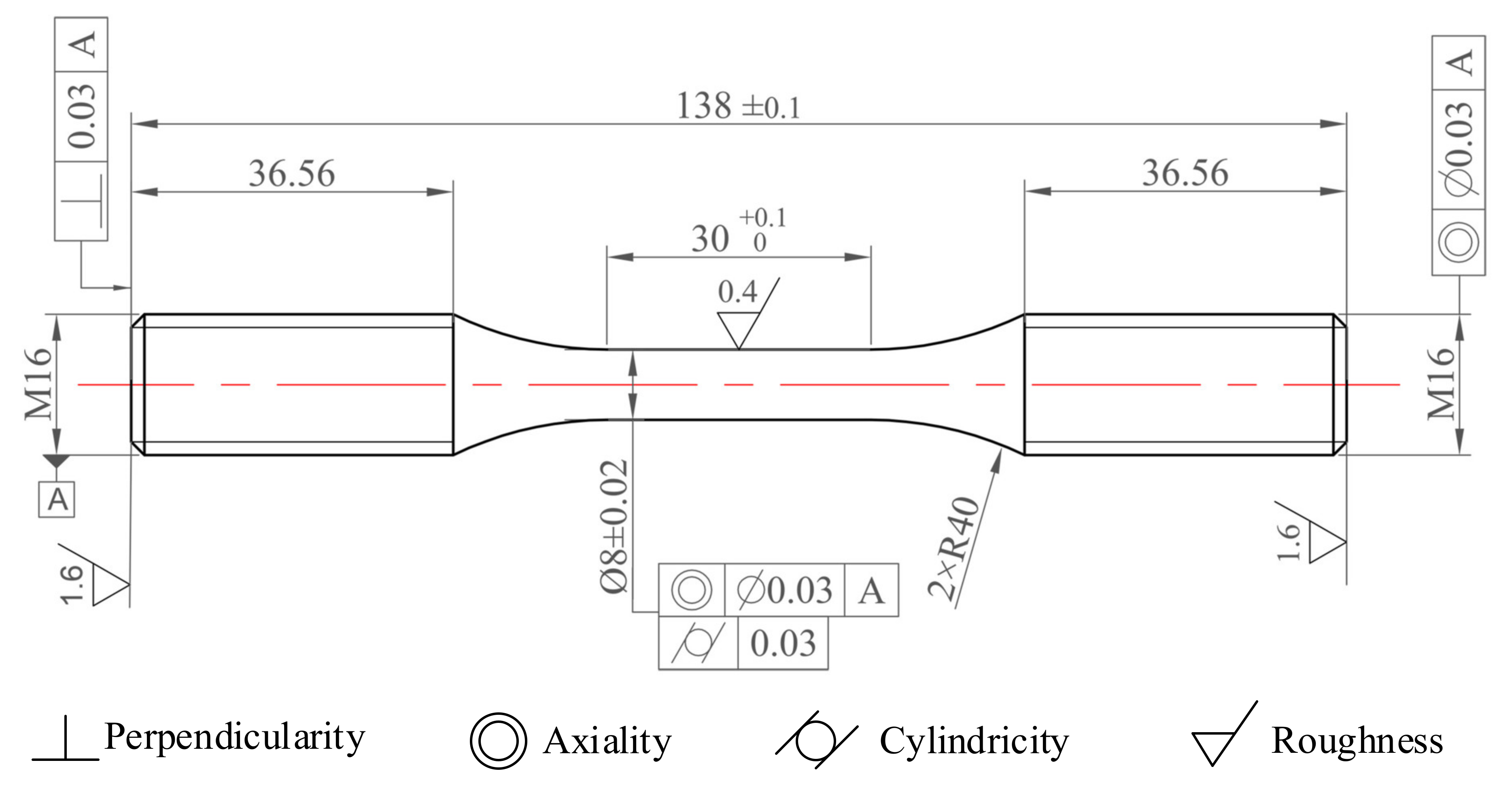

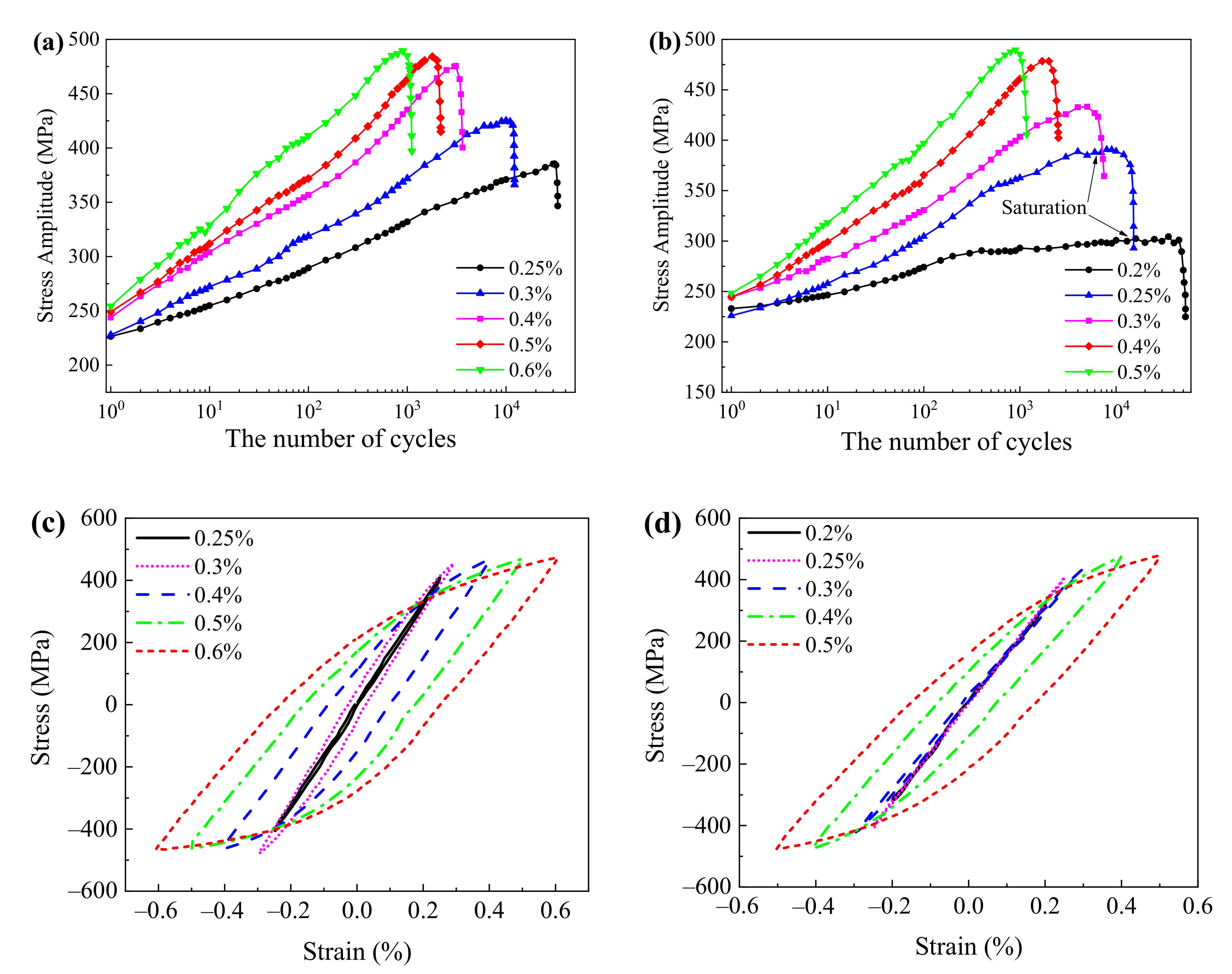

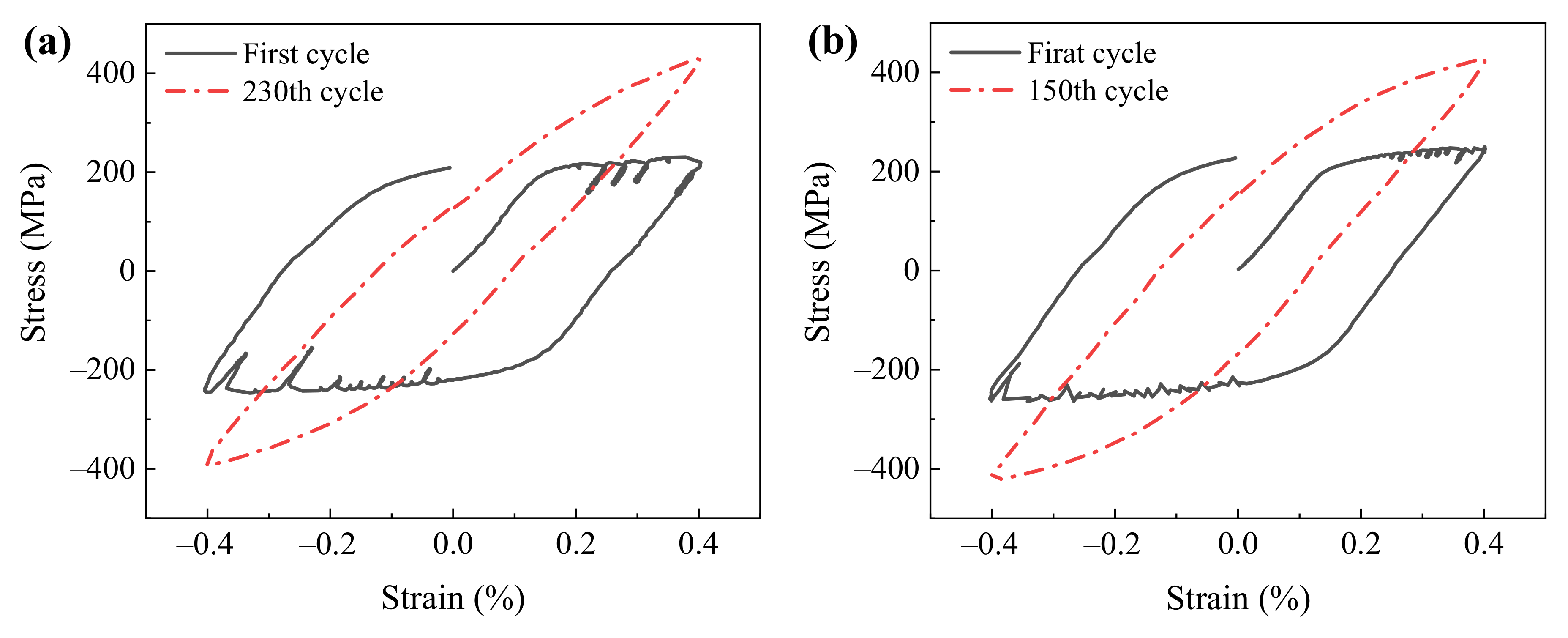
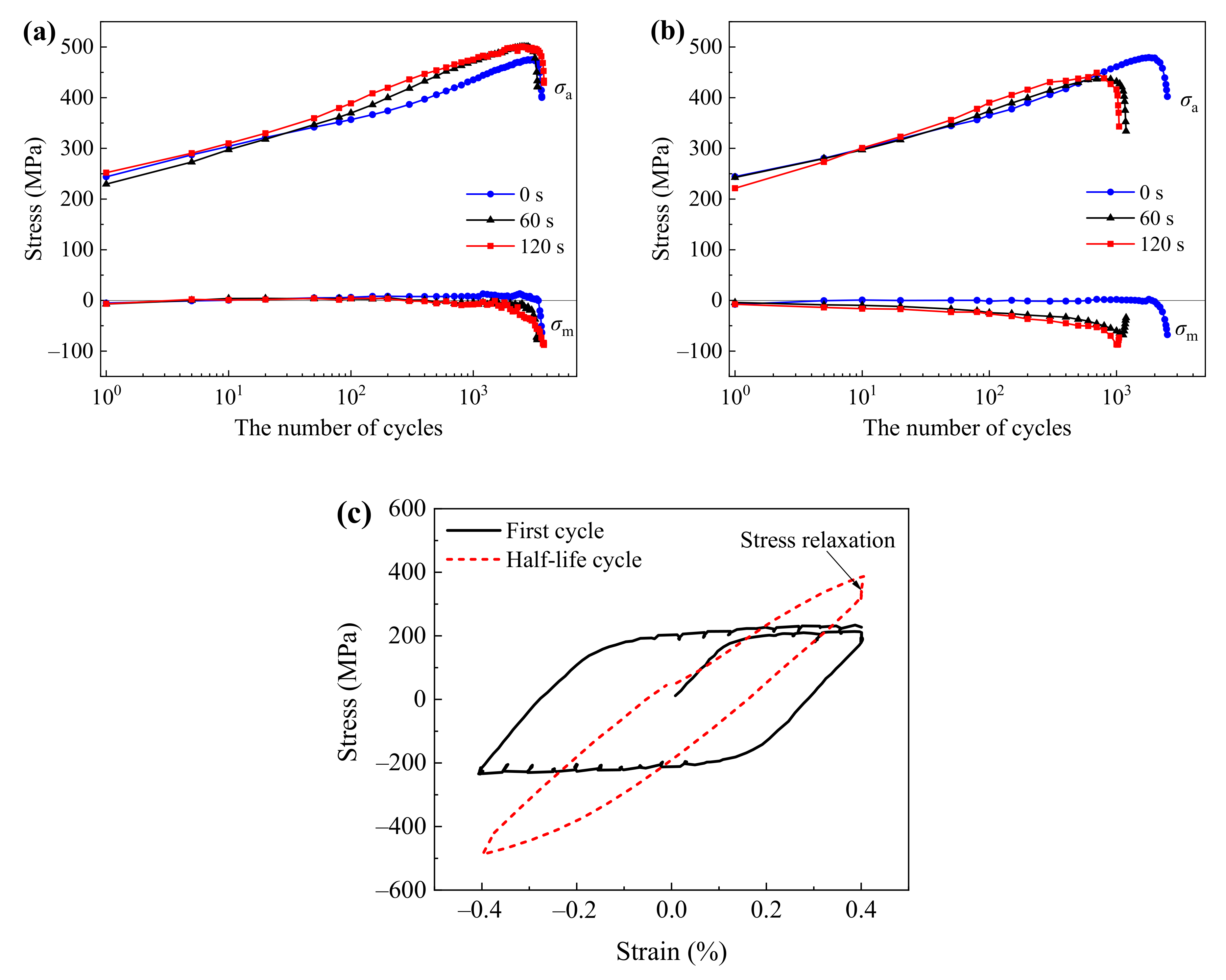
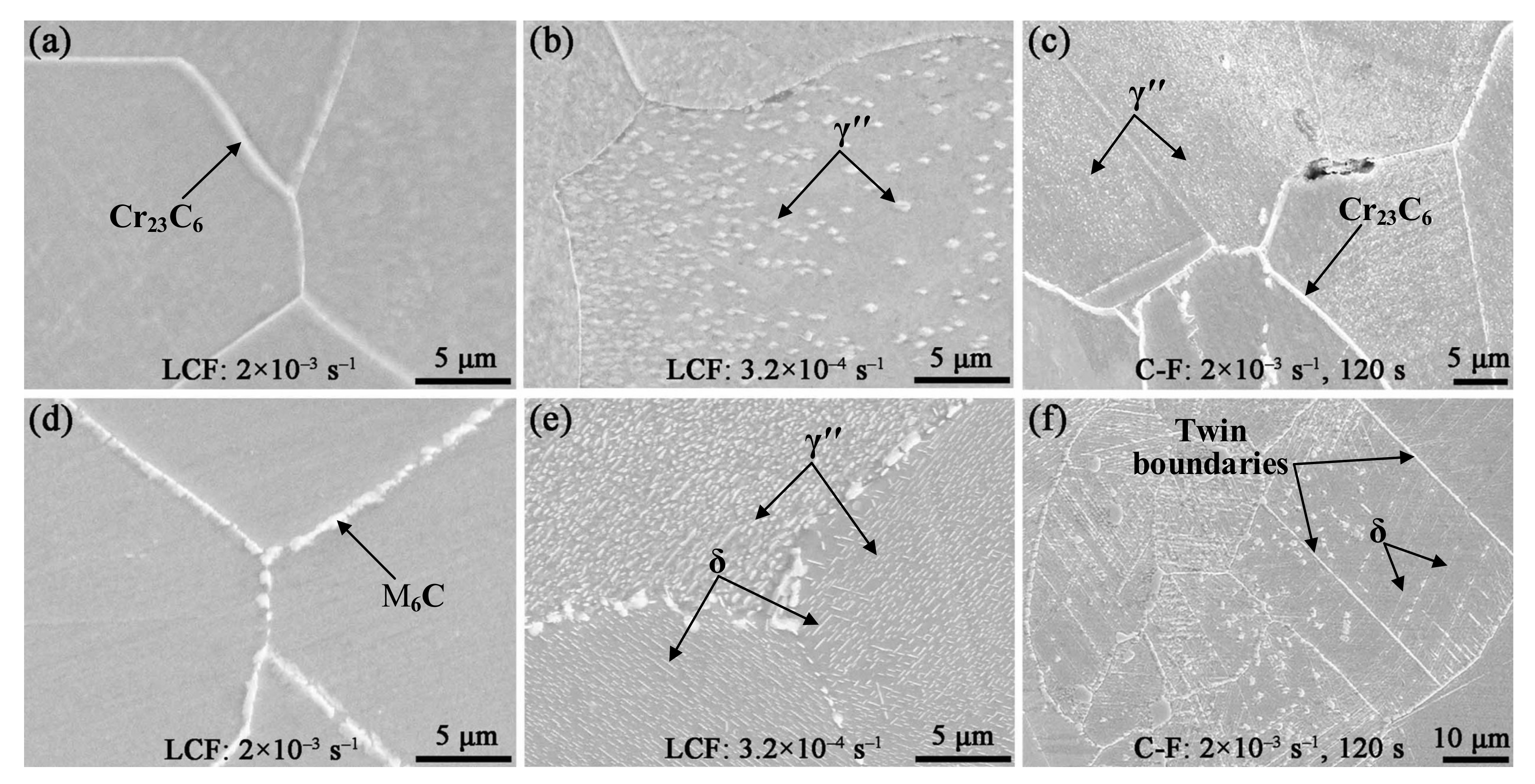
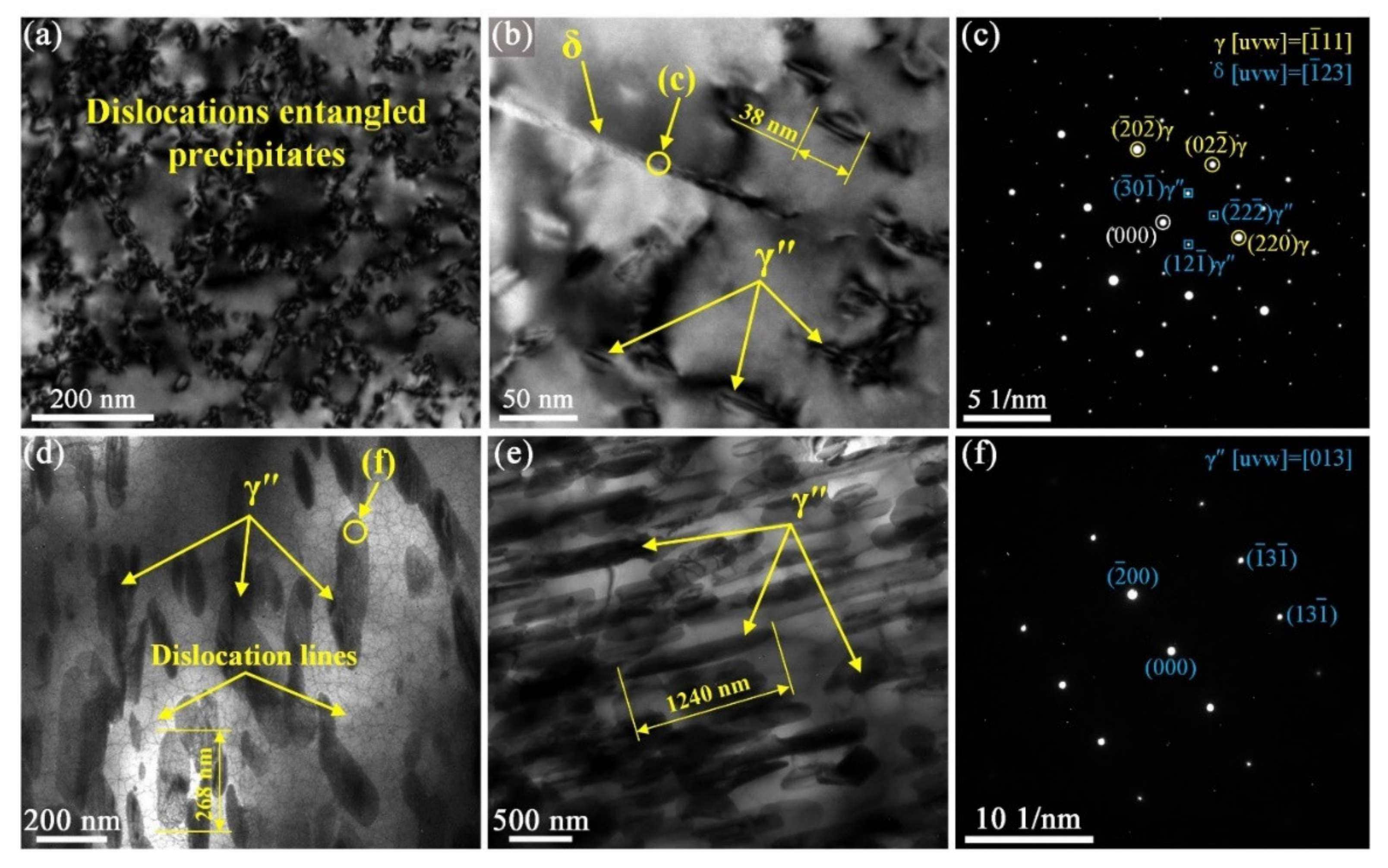

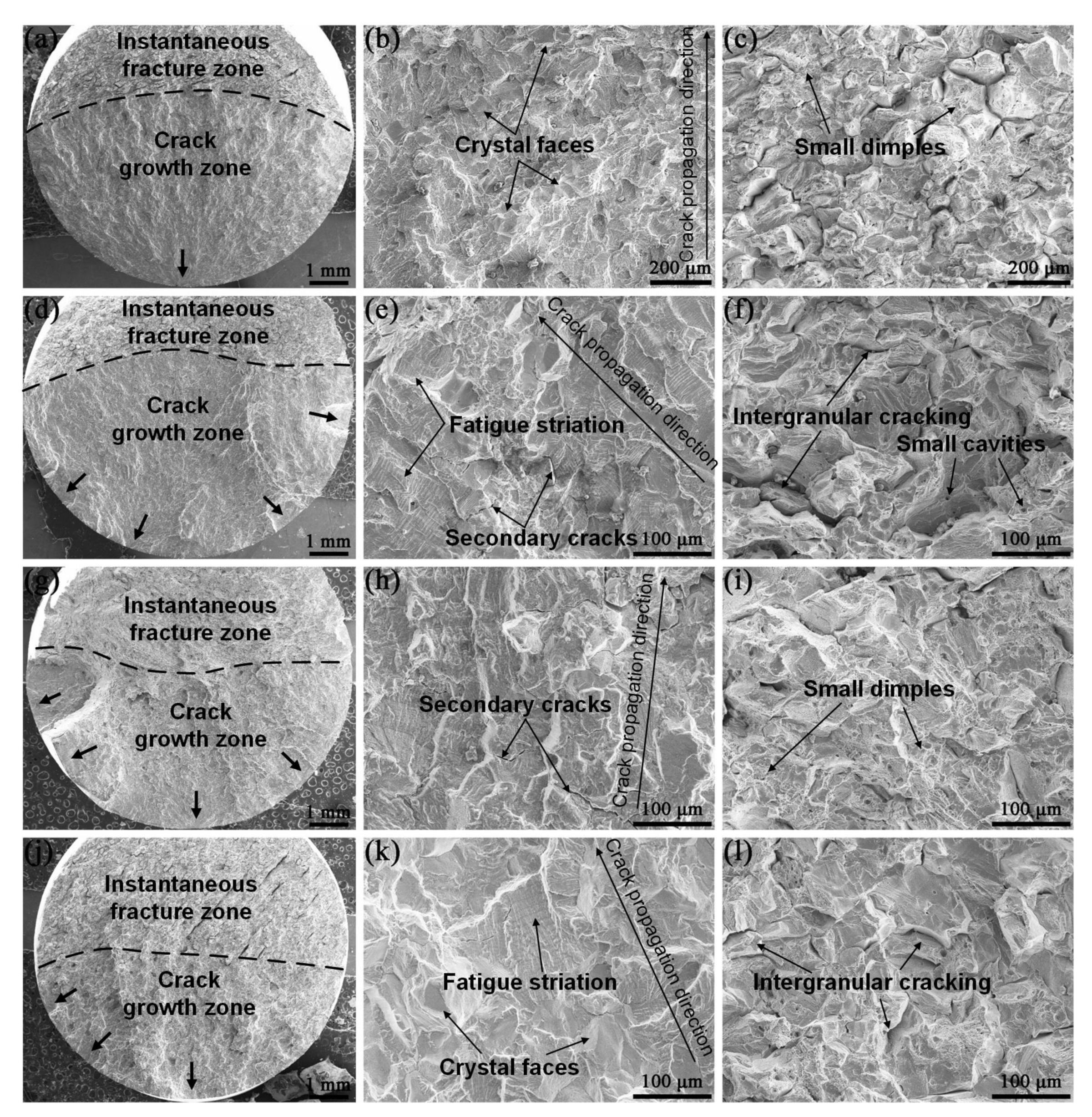


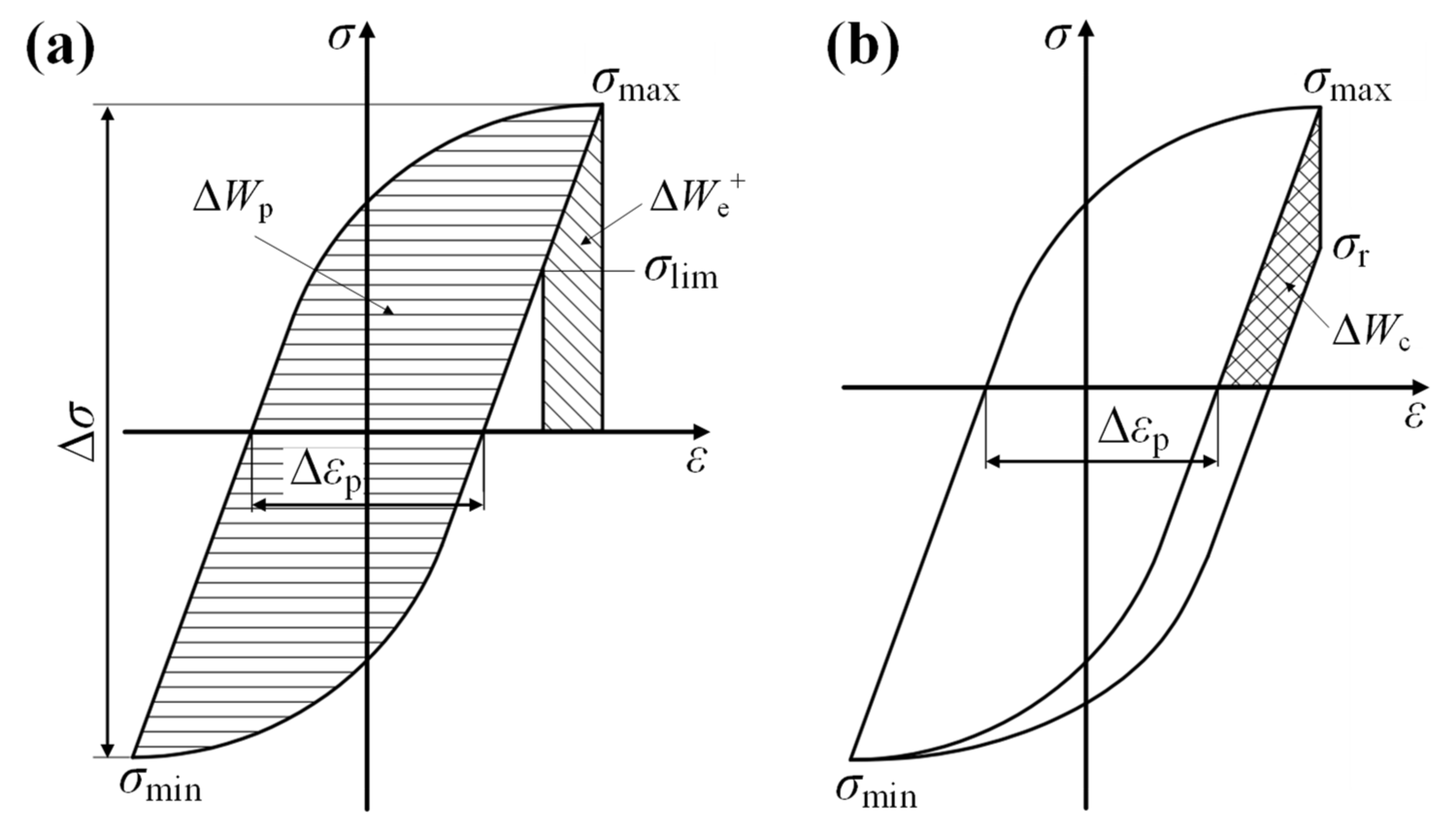
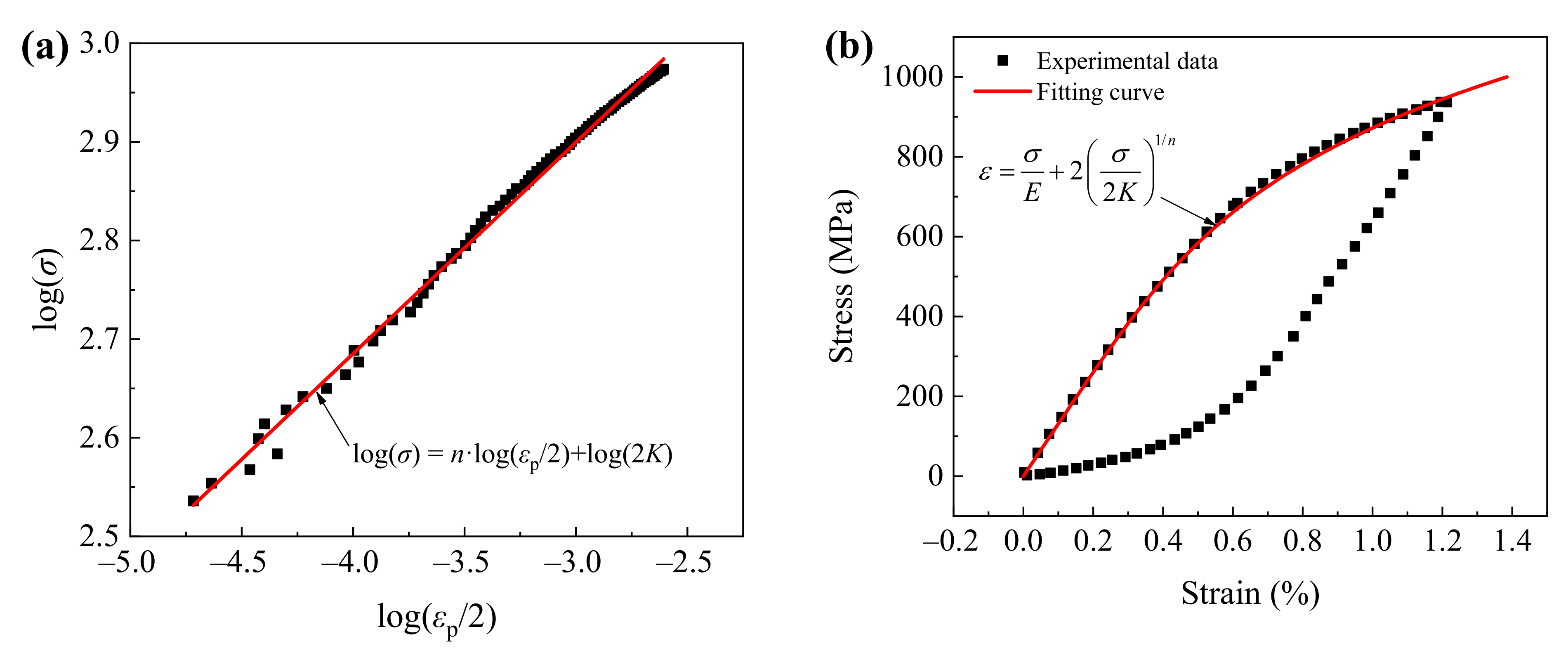

| Ni | Cr | Fe | Mo | Nb + Ta | Mn | Si | P | S | Al | Ti | Co | C |
|---|---|---|---|---|---|---|---|---|---|---|---|---|
| 59.6 | 22.7 | 4.93 | 8.05 | 3.28 | 0.143 | 0.319 | 0.009 | 0.006 | 0.194 | 0.29 | 0.067 | 0.035 |
| Temp. (°C) | Test Type | Strain Rate (s−1) | Stress Amplitude ∆ε/2 | Hold Time th (s) | Cycle Period tc (s) |
|---|---|---|---|---|---|
| 700 | LCF | 2 × 10−3 | 0.25% | - | 5 |
| 0.3% | - | 6 | |||
| 0.4% | - | 8 | |||
| 0.5% | - | 10 | |||
| 0.6% | - | 12 | |||
| 3.2 × 10−4 | 0.4% | - | 50 | ||
| 1.6 × 10−4 | - | 100 | |||
| C–F | 2 × 10−3 | 0.4% | 60 | 68 | |
| 120 | 128 | ||||
| 800 | LCF | 2 × 10−3 | 0.2% | - | 4 |
| 0.25% | - | 5 | |||
| 0.3% | - | 6 | |||
| 0.4% | - | 8 | |||
| 0.5% | - | 10 | |||
| 3.2 × 10−4 | 0.4% | - | 50 | ||
| 1.6 × 10−4 | - | 100 | |||
| C–F | 2 × 10−3 | 0.4% | 60 | 68 | |
| 120 | 128 |
| Temp. (°C) | E (GPa) | K (MPa) | n | C (MPa) | α | β |
|---|---|---|---|---|---|---|
| 700 | 151.6 | 3095 | 0.218 | 5479 | 0.045 | −1.132 |
| 800 | 149.3 | 2623 | 0.184 | 6103 | 0.275 | −1.129 |
Publisher’s Note: MDPI stays neutral with regard to jurisdictional claims in published maps and institutional affiliations. |
© 2022 by the authors. Licensee MDPI, Basel, Switzerland. This article is an open access article distributed under the terms and conditions of the Creative Commons Attribution (CC BY) license (https://creativecommons.org/licenses/by/4.0/).
Share and Cite
Wu, Z.; Chen, X.; Fan, Z.; Zhou, Y.; Dong, J. Studies of High-Temperature Fatigue Behavior and Mechanism for Nickel-Based Superalloy Inconel 625. Metals 2022, 12, 755. https://doi.org/10.3390/met12050755
Wu Z, Chen X, Fan Z, Zhou Y, Dong J. Studies of High-Temperature Fatigue Behavior and Mechanism for Nickel-Based Superalloy Inconel 625. Metals. 2022; 12(5):755. https://doi.org/10.3390/met12050755
Chicago/Turabian StyleWu, Zhenxing, Xuedong Chen, Zhichao Fan, Yu Zhou, and Jie Dong. 2022. "Studies of High-Temperature Fatigue Behavior and Mechanism for Nickel-Based Superalloy Inconel 625" Metals 12, no. 5: 755. https://doi.org/10.3390/met12050755
APA StyleWu, Z., Chen, X., Fan, Z., Zhou, Y., & Dong, J. (2022). Studies of High-Temperature Fatigue Behavior and Mechanism for Nickel-Based Superalloy Inconel 625. Metals, 12(5), 755. https://doi.org/10.3390/met12050755







